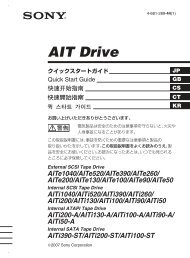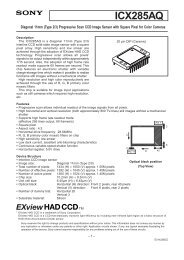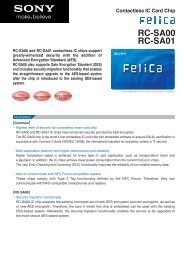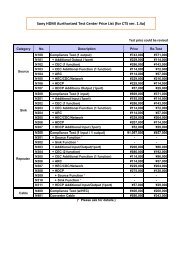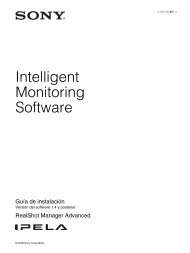PDF [4833KB] - Sony
PDF [4833KB] - Sony
PDF [4833KB] - Sony
Create successful ePaper yourself
Turn your PDF publications into a flip-book with our unique Google optimized e-Paper software.
however, complicated functionality has become<br />
concentrated on semiconductors and other key<br />
digital devices. Since these semiconductors and<br />
key devices are able to be mass produced, they<br />
have become readily available to new market<br />
entrants, and the functionality that once commanded<br />
a high premium has become more<br />
affordable. This has led to intense price erosion<br />
in the end-user consumer AV products market.<br />
To respond to these challenges, <strong>Sony</strong> is striving<br />
to keep pace with price erosion by reducing its<br />
manufacturing and other costs. It is seeking<br />
to maintain the premium pricing it enjoys on<br />
many of its end-user products by adding<br />
functionality to those products and developing<br />
new applications and ways of use that are<br />
then communicated to the consumer. And it<br />
is taking steps to increase its competitive<br />
edge by developing high value-added semiconductors<br />
and other digital key devices inhouse.<br />
By increasing the ratio of key devices<br />
produced in-house, <strong>Sony</strong> aims to capture the<br />
value that has become increasingly concentrated<br />
in those devices.<br />
In the area of semiconductors, <strong>Sony</strong> invested<br />
69 billion yen in the fiscal year ended<br />
March 31, 2004 and plans to invest 120 billion<br />
yen in the fiscal year ending March 31, 2005<br />
on semiconductor fabrication equipment built<br />
at the 65 nanometer level of process technology.<br />
These chips will be some of the most<br />
highly advanced on the market, and will include<br />
the new microprocessor for the broadband<br />
era, code-named Cell, as well as other<br />
system large scale integration (“LSI”) for use in<br />
the next generation computer entertainment<br />
system and a variety of future consumer electronics<br />
products. <strong>Sony</strong> began developing Cell<br />
together with IBM Corporation and Toshiba<br />
Corporation in the spring of 2001. To ensure<br />
efficient use of all the semiconductor production<br />
facilities in the <strong>Sony</strong> Group, <strong>Sony</strong> is also<br />
planning to consolidate the semiconductor<br />
fabrication facilities of the Electronics and<br />
Game segments into one organization on July<br />
1, 2004.<br />
In the area of other key devices, <strong>Sony</strong> is<br />
currently investing in 7th generation amorphous<br />
TFT LCD panel production equipment, reflecting<br />
its belief that demand for LCD televisions<br />
will continue to increase rapidly. <strong>Sony</strong> is investing<br />
one billion U.S. dollars in a joint venture it<br />
has established with Samsung, named S-LCD<br />
Corporation, and based in South Korea.<br />
Samsung holds 50 percent plus one share of<br />
the equity of the joint venture while <strong>Sony</strong> holds<br />
50 percent minus one share of the equity of<br />
the joint venture. The President and CEO<br />
comes from Samsung while the CFO comes<br />
from <strong>Sony</strong>. Investment in manufacturing<br />
equipment will begin in the summer of 2004<br />
while mass production of LCD panels is expected<br />
to begin in the second calendar quarter<br />
of 2005. Expected production capacity is<br />
60,000 sheets per month at the 7th generation<br />
(1,870 mm x 2,200 mm) level of technology.<br />
GAME<br />
In the Game segment, PlayStation 2 has a high<br />
share of the global game console market, and<br />
the PlayStation 2 business, particularly the<br />
PlayStation 2 software business, remains in its<br />
harvest stage. However, production shipment<br />
units of PlayStation 2 hardware are expected<br />
to decrease in the fiscal year ending March 31,<br />
2005. In order to ensure future growth in the<br />
Game segment, <strong>Sony</strong> is investing, as described<br />
above, in the research and development of<br />
cutting-edge microprocessors and other LSIs<br />
that will be used in the next generation computer<br />
entertainment system. Furthermore,<br />
<strong>Sony</strong> is working to develop a new market<br />
through its planned introduction, in the fiscal<br />
year ending March 31, 2005, of PlayStation<br />
Portable (“PSP”), a new handheld game system<br />
on which a variety of content can be enjoyed.<br />
MUSIC<br />
In the Music segment, album sales over the<br />
past several years have decreased due to the<br />
worldwide contraction of the global music<br />
industry brought on by piracy and competition<br />
from other entertainment sectors. Although<br />
<strong>Sony</strong> experienced improvement in a number of<br />
key retail markets during the fiscal year ended<br />
March 31, 2004, it continued to record declining<br />
sales on a global basis. In an effort to<br />
maintain profitability, <strong>Sony</strong> is continuing to<br />
implement restructuring initiatives designed to<br />
reduce fixed costs at a rate equal to or above<br />
the rate of the decline in sales. <strong>Sony</strong> is also<br />
working to combat digital piracy and generate<br />
profits through digital distribution of content,<br />
most notably through its launch of the Connect<br />
music store, a digital downloading service.<br />
Finally, in an effort to achieve significant<br />
operational efficiencies, <strong>Sony</strong> is seeking to<br />
merge its recorded music business with BMG.<br />
In December 2003, <strong>Sony</strong> and Bertelsmann AG<br />
announced that they had signed a binding<br />
agreement to combine their recorded music<br />
businesses in a joint venture. The newly<br />
formed company, which will be known as<br />
<strong>Sony</strong> BMG, will be 50 percent owned by each<br />
parent company. The merger is subject to<br />
regulatory approvals in the U.S. and the<br />
European Union.<br />
PICTURES<br />
In the Pictures segment, <strong>Sony</strong> faces intense<br />
competition, rising advertising and promotion<br />
expenses and a growing trend toward digital<br />
piracy. To meet these challenges, <strong>Sony</strong> is<br />
working to distribute a diversified portfolio of<br />
motion pictures and capitalize on the expanding<br />
DVD home entertainment market, which is<br />
becoming a more significant source of revenues<br />
and profits. Additionally, to differentiate itself<br />
in the marketplace and to proactively address<br />
risks of digital piracy, <strong>Sony</strong> Pictures Digital is<br />
developing broadband network strategies to<br />
facilitate the integration between <strong>Sony</strong>’s hardware<br />
and content products and create protected<br />
revenue-generating alternatives.<br />
FINANCIAL SERVICES<br />
In the Financial Services segment, the value of<br />
assets accumulated by the businesses in the<br />
segment has grown continuously over the past<br />
several fiscal years, resulting in a large portion<br />
of <strong>Sony</strong>’s total assets being accounted for by<br />
the Financial Services segment. To strengthen<br />
asset management and risk management in<br />
parallel with this growing asset value, enhance<br />
disclosure of business details, and offer customers<br />
integrated financial services tailored to<br />
their individual needs, <strong>Sony</strong> established <strong>Sony</strong><br />
Financial Holdings Inc. in April 2004. This company<br />
is comprised of <strong>Sony</strong> Life, <strong>Sony</strong> Assurance<br />
and <strong>Sony</strong> Bank, and will serve to increase the<br />
synergies between these businesses.<br />
82


![PDF [4833KB] - Sony](https://img.yumpu.com/26420643/84/500x640/pdf-4833kb-sony.jpg)

